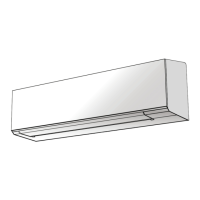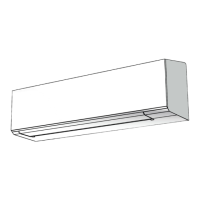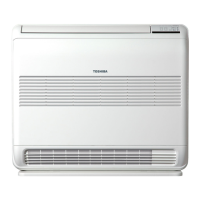Do you have a question about the Toshiba RAS-B16N3KV2-E and is the answer not in the manual?
Critical warnings for qualified personnel and installation practices.
Detailed warnings about installation, electrical work, and refrigerant handling.
Safety precautions specific to R410A refrigerant during installation and servicing.
Guidelines for installing refrigerant piping using appropriate materials.
Details on copper pipes, flare joints, and socket joints for piping.
Procedures for cutting pipes and preparing flare nuts for installation.
Dimensions and methods for flare processing R410A pipes.
Steps and precautions for connecting flare joints, including torque values.
Step-by-step procedure for recharging refrigerant.
Procedure for removing frost from the outdoor heat exchanger.
Conditions and procedures for defrost operation and return to heating.
Illustrates the placement and connection of indoor and outdoor units.
Steps for flaring and tightening refrigerant pipes.
Procedure for evacuating air from the piping system using a vacuum pump.
Power supply requirements and connecting power/control cables.
Safety precautions when working with the inverter, especially concerning high voltage.
Interprets flashing LED patterns on the indoor unit for self-diagnosis.
Executes self-diagnosis using the remote controller and interprets check codes.
Instructions for accessing and using the remote controller in service mode for diagnosis.
Troubleshooting steps for indoor unit issues, starting with power not turning on.
Diagnostic flowchart for when the unit does not power on at all.
Troubleshooting when the unit still doesn't power on after replacing the PC board.
Diagnostic flowchart for when only the indoor fan motor fails to operate.
Troubleshooting for the indoor fan motor rotating automatically upon power-on.
Flowchart for diagnosing issues with the remote control.
Diagnosing wiring issues and outdoor unit stopping after operation.
Diagnosing wiring issues causing the outdoor unit not to operate.
Troubleshooting when the outdoor unit stops after starting and requires power cycling.
How to check main parts like pulse motor valve and sensors.
Procedures for checking PMV and temperature sensors.
Step-by-step diagnosis for the inverter assembly in the outdoor unit.
Procedures for checking the indoor unit's P.C. board for defects.
Methods for checking individual parts for proper function.
How to determine if the outdoor fan motor is functioning correctly.
Critical safety warnings before attempting any part replacement.
Procedures for removing and installing the inverter assembly, including capacitor discharge.
Procedures for replacing the fan motor and compressor.
Critical warnings for qualified personnel and installation practices.
Detailed warnings about installation, electrical work, and refrigerant handling.
Safety precautions specific to R410A refrigerant during installation and servicing.
Guidelines for installing refrigerant piping using appropriate materials.
Details on copper pipes, flare joints, and socket joints for piping.
Procedures for cutting pipes and preparing flare nuts for installation.
Dimensions and methods for flare processing R410A pipes.
Steps and precautions for connecting flare joints, including torque values.
Step-by-step procedure for recharging refrigerant.
Procedure for removing frost from the outdoor heat exchanger.
Conditions and procedures for defrost operation and return to heating.
Illustrates the placement and connection of indoor and outdoor units.
Steps for flaring and tightening refrigerant pipes.
Procedure for evacuating air from the piping system using a vacuum pump.
Power supply requirements and connecting power/control cables.
Safety precautions when working with the inverter, especially concerning high voltage.
Interprets flashing LED patterns on the indoor unit for self-diagnosis.
Executes self-diagnosis using the remote controller and interprets check codes.
Instructions for accessing and using the remote controller in service mode for diagnosis.
Troubleshooting steps for indoor unit issues, starting with power not turning on.
Diagnostic flowchart for when the unit does not power on at all.
Troubleshooting when the unit still doesn't power on after replacing the PC board.
Diagnostic flowchart for when only the indoor fan motor fails to operate.
Troubleshooting for the indoor fan motor rotating automatically upon power-on.
Flowchart for diagnosing issues with the remote control.
Diagnosing wiring issues and outdoor unit stopping after operation.
Diagnosing wiring issues causing the outdoor unit not to operate.
Troubleshooting when the outdoor unit stops after starting and requires power cycling.
How to check main parts like pulse motor valve and sensors.
Procedures for checking PMV and temperature sensors.
Step-by-step diagnosis for the inverter assembly in the outdoor unit.
Procedures for checking the indoor unit's P.C. board for defects.
Methods for checking individual parts for proper function.
How to determine if the outdoor fan motor is functioning correctly.
Critical safety warnings before attempting any part replacement.
Procedures for removing and installing the inverter assembly, including capacitor discharge.
Procedures for replacing the fan motor and compressor.
| Energy Efficiency Ratio (EER) | 3.21 |
|---|---|
| Seasonal Energy Efficiency Ratio (SEER) | 6.1 |
| Power Supply | 220-240 V, 50 Hz |
| Refrigerant | R32 |
| Weight (Indoor Unit) | 9 kg |
| Coefficient of Performance (COP) | 3.61 |
| Type | Split Air Conditioner |
| Noise Level (Indoor Unit) | 21 dB |











